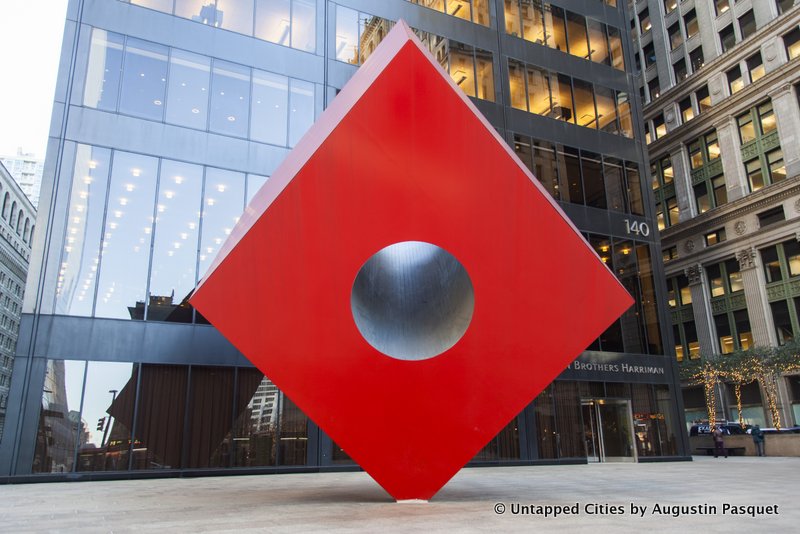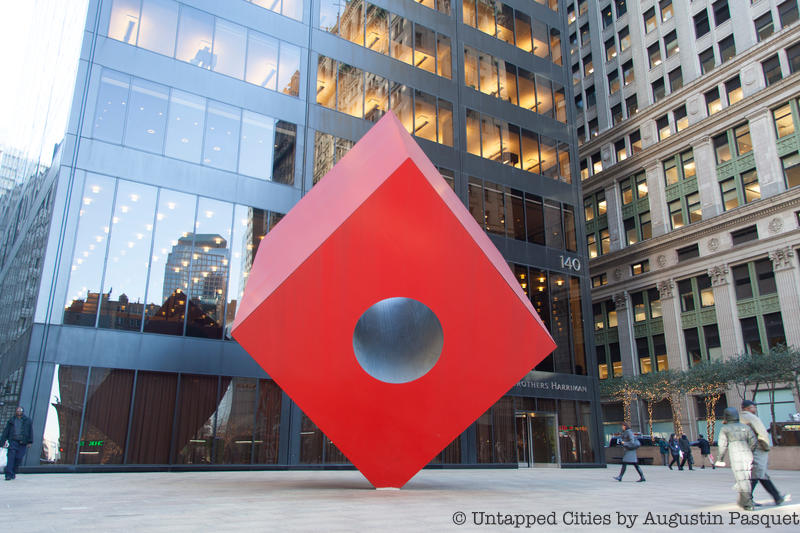
In a city founded upon the latest innovations in design and technology, one can expect change to rapidly take place. Such development is generally welcomed, but this is not the case for the 140 Broadway. The Modernist, Brown Brothers Harriman building in Lower Manhattan, noted for its plaza and tilted Red Cube by Isamu Noguchi, is now under threat. It was recently named a “Landslide at-risk landscape” by the Cultural Landscape Foundation.
Earlier in January, the owners of the property asked the Landmarks Preservation Commission (LPC) to approve the redesign of the plaza, which includes the removal of features that were added after the original mid-1960s design. This includes a plaque dedicated to developer Harry B. Helmsley, located near the corner of Cedar and Broadway, as well as four linear planting boxes; to potentially take their place are six, circular planters that offer seating options, and eight light bollards.
Additionally, plaza owners are submitting a request to the NYC Department of Transportation (NYC DOT) to construct four, rectangular planters and five benches along Broadway, which they hope will fend off the food-vending trucks that park outside of the building. The idea has since received backlash from a representative of the Street Vendor Project and a current plaza vendor during a monthly Community Board 1 meeting, which took place on January 23.
“Having reviewed details and renderings of the proposal now under review by the Landmarks Preservation Commission, it is clear that the redesign of the plaza would adversely affect the integrity of what has been designated a New York City Landmark,” said Charles A. Birnbaum, President & CEO of the Cultural Landscape Foundation.
“We believe it is imperative that the Landmarks Preservation Commission deny any request to place additional site furnishings or landscape features there. We hope that you will agree that the best design for the plaza, and those who encounter it, is the original minimalist vision borne from the collaboration of two masters, which remains a much-admired benchmark for future urban design.”
In a letter to the LPC, the Cultural Landscape Foundation argues that the new design features would “visually rebalance the plaza, negating the Red Cube as the solitary, dominant element on the ground plane.” This would “adversely” affect the experience of Noguchi’s sculpture, as well as the building and plaza as a whole. After all, the site in which a piece is exhibited can be just as important as the sculpture itself. Noguchi, in recognizing this important relationship, once noted: “a sculptor is not merely a decorator of buildings but a serious collaborator with the architect in the creation of significant space and of significant shapes which define this space.”
Designed by Gordon Bunshaft for Skidmore, Owings, & Merrill, the skyscraper opened in 1968 and was designated a New York City landmark in 2013. At the time, famed New York Times architecture critic, Ada Louise Huxtable, described the plaza as a “demonstration of New York at its physical best.”
CurbedNY reports that NV5 firm, in charge of the redesign, will present its proposals to the LPC on February 6. We’ll keep you updated on the status of the building.
Next, check out NYC Skyscraper Museum Looks Back at Lower Manhattan’s Decline & Rebirth in the 1990s.






